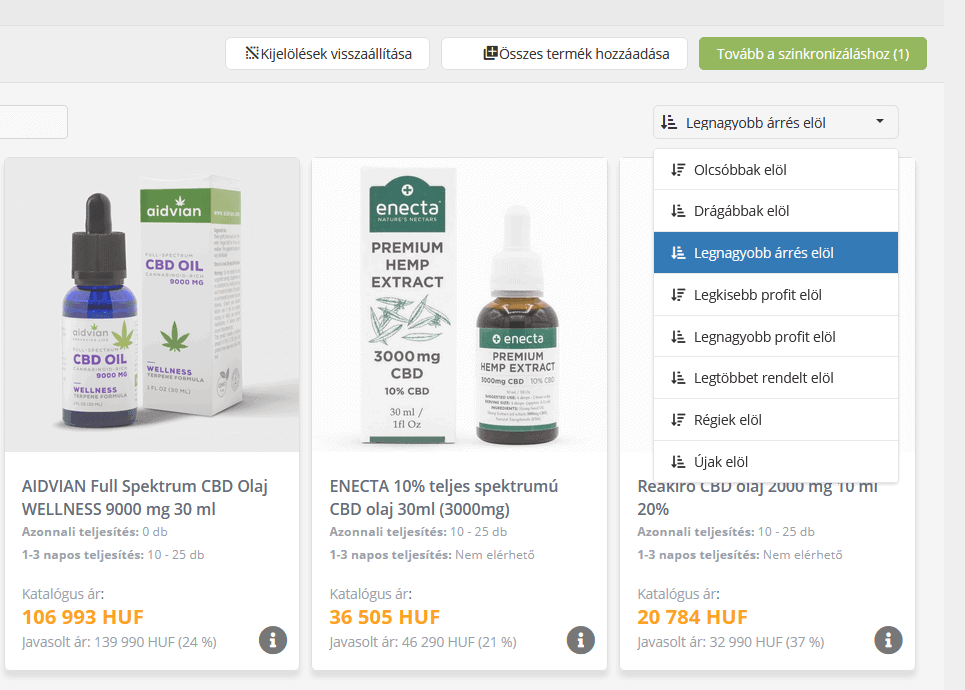What should your guiding principle be? What price should you set for a given product? How do you know what price it will sell for? Most importantly, stay realistic and get comfortable with pricing.
The 3 -legged pricing strategy serves as a good basis for every webshop to quickly increase profits. However, dropshipping provides even further opportunities to exploit.
Over 1000 webshops select their products from the Webshippy marketplace. We’ll present the elements of pricing strategy through their example. At the same time, needless to say, that this method is applicable to all other dropshipping platforms and most of these tips can be successfully implemented in terms of your own inventory also.
Let’s see… You’ve decided to launch your own webshop. You’ve picked the webshop to rent, with a few simple clicks connected it to the Webshippy market place and listed all the products that you would like to offer for sale. Your sales are ready for take-off as the wholesale consumer price is already indicated on your surface, thanks to synchronization. The ball is in your court now to decide whether and in what way you’d like to modify these recommended prices.
Basically, we can approach pricing in three ways:
- Cost-based pricing strategy
- Competitor-based pricing
- Value-based pricing
All three of these may seem like good strategies, but following only one or the other is debatably not going to lead to success. Let’s take a closer look at what aspects to consider, and the crutches you can use with regards to pricing.
Keep in mind what the product costs you
You are in a particularly cushy situation as you are selling products made by other people. You don’t need to deal with the cost of manufacturing and it’s enough to glance at the list of gross prices in Webshippy’s brochure to figure out how much the given product will cost you.
The gross catalogue price is infallible as it is the exact amount that will automatically be invoiced to you by the manufacturing company when placing an order through your webshop. Once paid for, the package leaves our warehouse making its way to the customer.
Tip: Cost-based pricing strategy can come most handy when you’re setting discounted prices, or you’d like to boost sales by putting together package deals. In the midst of setting really attractive bargains, you can easily lose sight of the true cost of products.

Have a clue about the value of the product!
A good benchmark for value-based pricing is the recommended retail price that you always find in the product details at Webshippy Marketplace. Manufacturers provide this information exactly to help resellers with pricing.
When products are selected from the Webshippy catalogue, it’s already the consumer prices that are indicated to your webshop customers, thanks to product synchronization.
In case you decide to stay with this default setting, you will receive the incoming orders with the recommended retail prices and your profit is what you see indicated in the margin section.
Tip: Obviously, you can sell the products at your own webshop at any price you wish, increasing or lowering the recommended retail prices. View this as a guiding principle that gives you the general value of the given product in the eyes of the customers. In addition, you can conduct target group analysis and fine-tune your initial ideas. Google analytics and FB audience data can prove very practical in finding out more on who your target group may be.
What prices have others set the product? Keeping a watchful eye on your competitors
Should you change your prices? You may wish to exploit the possibilities the internet has to offer and set your own current prices, or perhaps prefer to keep the price of a special, seasonal or niche product flexible. One of the best things in having our own e-commerce business is that we are completely at liberty to experiment.
Before you do so, it’s strongly advisable to conduct small research to see what prices do others – perhaps websites regarded as competition – work with. You can use so-called price comparison sites (Árukereső, ÁrGép, etc.) to collect the information and get a clearer picture of the highest and lowest prices of the products. You will also see the competition you are facing while doing this.
Tip: It may not be worth paying too much attention to competitors in the long-run, but when setting the prices of your “star products” it can be advantageous to know what prices your target group will find when doing a search on Google or some popular price comparison sites. So do the same and be on top of things by doing a search on the products in your own portfolio.

Set prices that appeal to the mind – physiological tricks
Why do prices that end in number 9 work?
It’s a well-known fact that prices that end in number 9 catch the eye and spike buyers’ interest.
This phenomenon can be explained by the way we read – in most cases from left to right. Prices starting with a lower number and ending in 9 gives our brain the message that the offer is at a great price (first digit close to zero), and is valuable (last digit close to 10).
Tip: By offering a 5000 FT product at the price of 4990 FT you trick the buyers’ subconscious into the bargain. Prices starting with 1 and ending in 9 works extremely well, therefore if you set prices in this category, do give this strategy a try!
1+1, or the many shades of the 50% sale
Many people resort to sales and discounts to generate more business on their site. If we think back to price comparison sites, you’ll find a sizeable number of webshops with the sales ticket flashing on almost each and every one of their products. Obviously, their marketing strategy is based on impulse buying and rash decision-making.
If we intend to use promotions as attention grabbers, we must be professional. Just as winning the case of prices that end in 9, we can boost our sales with catchy phrasing when it comes to discounts as well.
Buy one, get one free!
Get two at half-price!
1+ 1 sale!
Get one as a gift!
Practically they all mean the same thing, but not all phrases work equally well. The majority of people respond favorably to the options offering a free product or a gift.
Tip: You can use this technique with package sales as well. You can add a gift product or a free product (based on certain conditions) to the group of purchased items.* Attention! Keep in mind that there are fixed costs in the case of gifts as well.
Outlet pricing, clearing the stock of warehouses and clearance sales
The good news is that as our reseller partner you will never have to deal with outlet prices. This is exactly one of the best perks of the dropshipping sales model. Since you don’t have your own inventory, you are not paying for the storage of the products in your webshop, therefore you will not find yourself in a situation where you’re forced to sell your products below price or urgently get rid of your stock because of space constraints either.
Tip: Regardless, you can launch nominal seasonal clearance sales. For instance, at this time of the year, at the end of summer you launch a sale on pool accessories or barbecue stuff. When organizing a promotion, put all discounted items under one menu heading to direct all the business coming in from the ads here.
Profit or margin? Filtering the Webshippy catalogue
There are different types of filter options in Webshippy’s resale catalogue that help you put together your product portfolio quickly. For instance, organizing the items by largest profit or margin enables you to see given category products with the largest margin between the catalogue and recommended retail price first. By setting the profit, you’ll see the exact amount, while in case of setting the margin, you’ll see the percentage amount that you can earn on the given product.

Conclusion: the holy trinity of cost, revenue and profit
Having a foolproof pricing strategy is absolutely essential to operate a profitable and successful webshop. A lot of businesses follow only the first step in the above detailed list – and especially concerning the webshops selling through the dropshipping model – obsessing over their competitors’ prices (slightly going above or below them in order to gain an advantage on the price comparison sites).
Pricing is a sensitive issue and we don’t recommend you to follow a tactic that only targets setting the lowest possible prices. Engaging in this war can easily mean losing all your profit while jeopardizing the value or reputation of your product, and making it so much more difficult to sell later.
If you want to secure your profit and aim for the middle-ground, don’t forget that your success depends on the holy trinity of costs, revenue, and profit.
A quick recap of the most important points:
Always know the purchase price of the product – even more so since the wholesaler invoices this amount and this is what you need to pay for your order to be on its way from the fulfillment center of Webshippy to your customer.
Take the recommended retail price by the wholesaler into consideration, which clearly indicates what the product’s value and the price is in the eyes of customers. Therefore, it serves as a great clue for value-based pricing.
Use psychological tricks for a home run!

